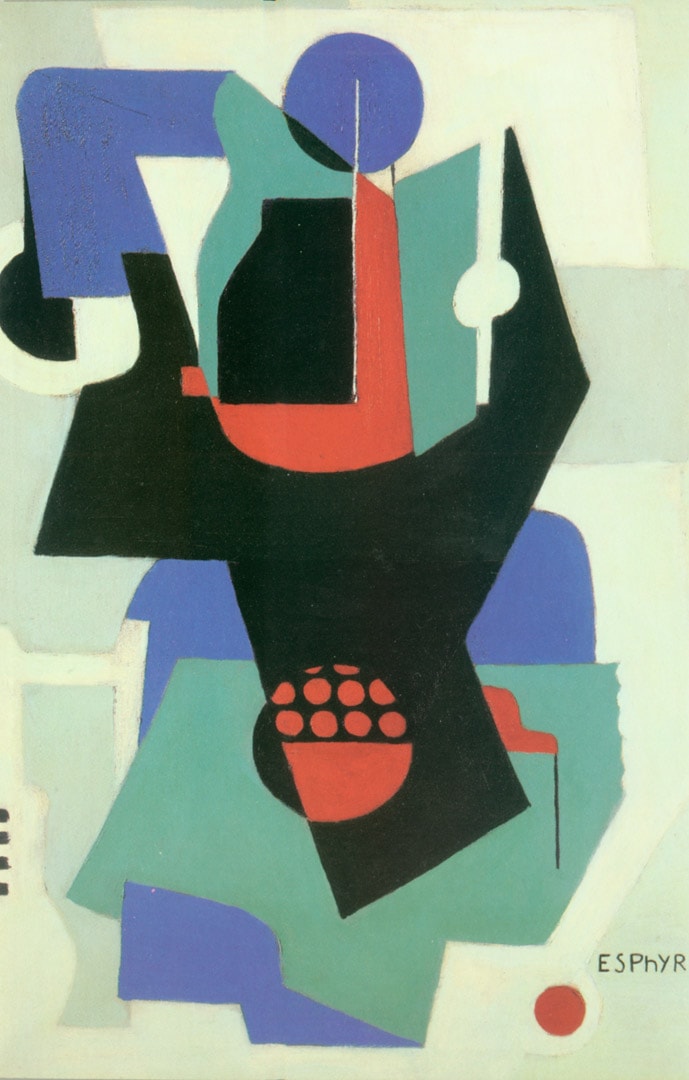The Pot-Bellied Stove
Year: 1936-37
Type: Painting
Catalog #: SF_0742
Current Location:
Metropolitan Museum of Art
Exhibition History:
Exhibited at the Met, 1994. Tufts Show, 1992. “Rediscovering Slobodkina: A Pioneer of American Abstraction,” Heckscher Museum, Huntington NY, Dec 2008-Mar 2009
Dimensions:
35 x 24
Painted during a highly productive period in the winter of 1936-37 when Slobodkina’s abstract art began to come into its own. Pot-Bellied Stove was one of two paintings of the stove in her East 58th Street studio. It was exhibited at the first American Abstract Artists show in April 1937 at the Squibb Galleries along with Still Life with Chair (Collection of Richard A. Lippe, Tuft’s catalog p.51) (The Life and Art of Esphyr Slobodkina, Tufts University Art Gallery, 1992, p.17). Slobodkina recalls: “The winter of 1936-7 was a very productive one for me. I began to concentrate more and more seriously on painting in the abstract, though I never gave up the pleasure of the more emotional, more direct self-expression in still life and landscape painting. The immediate events, though, called for concentration, for a rapid achievement in the abstract field. The first exhibition of our Group, finally named and officially established, was to take place early in the Spring at the Squibb Gallery on the corner of 57th street and 5th Avenue” (Notes for a Biographer, Volume II, p.426). Slobdkina recalls the landmark Squibb exhibition:
“The exhibition at the Squibbs Gallery was a tremendous success. Over fifteen hundred people took the trouble to see it, and the press, though mostly hostile, sat up and took notice…Each painter was allowed to show two pictures, and there were a number of striking sculptures. It looked lovely, it looked real, and my two paintings, among others, looked lovely and “real”! It was quite a beginning for a relatively young, and certainly inexperienced artist. Even in the short period between the execution of my first work and the second one, my point of view was shifting. The first, a free and yet faithfully Cubist representation of a still-life set up on an Early American chair, is in fact a much better realized assignment.
“The second one [The Pot-Bellied Stove], a larger and more ambitious work, like the lithograph in the catalog, reflected my new preoccupation with simplification of forms, nobility of design, and the beginning of my experimentation with ‘bending’ of the planes in order that they may serve space delineation in several directions. I painted that darn thing twice, trying to achieve perfection. I did not. It did have a nobly simple white background. Its design, based on an analytical dissection of my pot-bellied stove, was clever enough. The colors – uncompromisingly bold and clear. Yet there was a corner in this painting for which I could never find a solution. To this day, whenever I pass it, I cringe at the superficiality of the trick I employed to solve it. The signature, too, is the embodiment of the transitional period I was going through. After Esther Bolotowsky, Esphyr Bolotowsky, I was finally at the crossroads where I limited myself to signing briefly, and temporarily, as Esphyr” (Ibid., 487).
